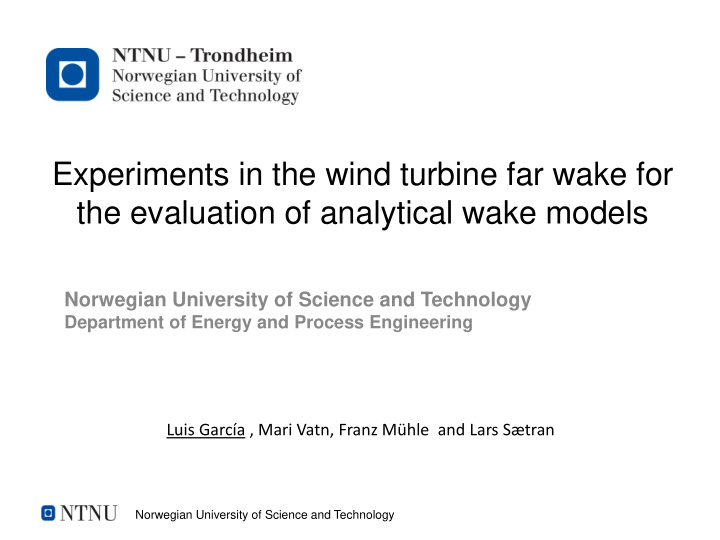



Experiments in the wind turbine far wake for the evaluation of analytical wake models Norwegian University of Science and Technology Department of Energy and Process Engineering Luis García , Mari Vatn, Franz Mühle and Lars Sætran Norwegian University of Science and Technology
Introduction • Wakes in wind farms: – Lower efficiency – Fluctuating loads Horns Rev offshore wind farm west of Denmark. Credit: Vattenfall 2 Norwegian University of Science and Technology
Introduction 𝑉 ∞ • Important to know the evolution of the parameters 3 Norwegian University of Science and Technology
Velocity decay & Width development 4 Norwegian University of Science and Technology
Analytical model • Schlichting model – Blunt bodies • Objective – Wind turbines 5 Norwegian University of Science and Technology
Parameters • Velocity Decay 𝑉 1 = 𝑉 ∞ − 𝑉 𝑐 1 2 𝑉 1 • Width development – Half depth width 𝑐 1 2 = 𝑔(𝑦, 𝑉 1 ) 6 Norwegian University of Science and Technology
Analytical description of wakes • Analytical expressions in terms of the downstream distance. Type of flow Width development Velocity decay 𝑦 1 2 𝑦 −1 2 2-D wake 𝑦 1 3 𝑦 −2 3 Circular wake 𝑉 1 = 𝐷 𝑣 ∙ 𝑦 −2 3 𝑐 1 2 = 𝐷 𝑐 ∙ 𝑦 1 3 𝑉 ∞ 𝐸 𝐸 𝐸 • Velocity distribution 𝑣 1 −2 3 2 10 𝑦 ∙ 1 − 𝑨 3 2 = 18𝛾 ∙ 𝑉 ∞ 𝐷 𝑈 𝐵 𝑐 Norwegian University of Science and Technology 7
Analytical description of wakes • Analytical expressions in terms of the downstream distance. Type of flow Width development Velocity decay 𝑦 1 2 𝑦 −1 2 2-D wake 𝑦 1 3 𝑦 −2 3 Circular wake 𝑉 1 = 𝐷 𝑣 ∙ 𝑦 −2 3 𝑐 1 2 = 𝐷 𝑐 ∙ 𝑦 1 3 𝑉 ∞ 𝐸 𝐸 𝐸 ln 𝑐 1 2 = ln 𝐷 𝑐 + 1 3 ln 𝑦 𝐸 𝐸 • Velocity distribution 𝑣 1 −2 3 2 10 𝑦 ∙ 1 − 𝑨 3 2 = 18𝛾 ∙ 𝑉 ∞ 𝐷 𝑈 𝐵 𝑐 Norwegian University of Science and Technology 8
Analytical description of wakes • Analytical expressions in terms of the downstream distance. Type of flow Width development Velocity decay 𝑦 1 2 𝑦 −1 2 2-D wake 𝑦 1 3 𝑦 −2 3 Circular wake 𝑉 1 = 𝐷 𝑣 ∙ 𝑦 −2 3 𝑐 1 2 = 𝐷 𝑐 ∙ 𝑦 1 3 𝑉 ∞ 𝐸 𝐸 𝐸 ln 𝑐 1 2 = ln 𝐷 𝑐 + 1 3 ln 𝑦 𝐸 𝐸 • Velocity distribution 𝑣 1 −2 3 2 10 𝑦 ∙ 1 − 𝑨 3 2 = 18𝛾 ∙ 𝑉 ∞ 𝐷 𝑈 𝐵 𝑐 Norwegian University of Science and Technology 9
Experimental setup • Full 2-D wakes • Instrumentation • Lines wakes – Wind tunnel • 2 turbulence ambient – Laser Doppler Velocimeter conditions – Turbine 10 Norwegian University of Science and Technology
Results of mean velocity 2 D full wakes • Downshift of the wake due to tower effect [1] [1] Pirella F and Sætran L 2017 Wind tunnel investigation on the effect of the turbine tower on wind turbines wake symmetry. Wind Energy (2017) 11 Norwegian University of Science and Technology
Results of mean velocity in the xz plane • Expansion of the wake • Decrease of the velocity decay 12 Norwegian University of Science and Technology
Discussion of the velocity decay Velocity decay Low TI Velocity decay High TI 𝑉 1 = 𝐷 𝑣 ∙ 𝑦 −2 3 • • Deviation of 2.0% Deviation of 2.5% 𝑉 ∞ 𝐸 13 Norwegian University of Science and Technology
Discussion of the width development Width development Low TI Width development High TI 𝑐 1 2 = 𝐷 𝑐 ∙ 𝑦 1 3 • Deviation of 3.0% • Deviation of 2.5% 𝐸 𝐸 14 Norwegian University of Science and Technology
Discussion of the velocity distribution • High degree of agreement • Some deviations in the edges −2 3 2 𝑣 1 10 𝑦 ∙ 1 − 𝑨 3 2 = 18𝛾 ∙ 𝑉 ∞ 𝐷 𝑈 𝐵 𝑐 15 Norwegian University of Science and Technology
Turbulence intensity 16 Norwegian University of Science and Technology
Turbulence intensity models • Three different models – Crespo and Hernandez – Quarton – Frandsen and Thogersen • Input parameters Parameter/Model Input parameters 𝐽 ∞ , a, D Crespo and Hernandez 𝐽 ∞ , 𝐷 𝑈 , 𝜓 𝑂 Quarton D, 𝑊 Frandsen and Thogersen ℎ𝑣𝑐 Norwegian University of Science and Technology 17
Results of turbulence intensity in the xz plane • Decrease of the added turbulence intensity 18 Norwegian University of Science and Technology
Discussion of turbulence intensity • Good agreement of the measurements with the models 19 Norwegian University of Science and Technology
Conclusion • Investigation of the Schlichting model for wind turbines • Good agreement between experiments and theory • Gaussian shape prediction • Fairly well prediction of the turbulence intensity of the wake • Analytical models can describe the wake characteristics Norwegian University of Science and Technology 20
Conclusion • Investigation of the Schlichting model for wind turbines • Good agreement between experiments and theory. • Gaussian shape prediction • Fairly well prediction of the turbulence intensity of the wake • Analytical models can describe the wake characteristics Thank you for your attention, Questions, comments? Norwegian University of Science and Technology 21
Recommend
More recommend